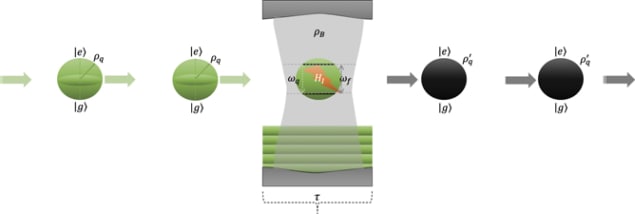Micromasers make a promising platform for quantum batteries
12 Oct 2022 Naomi Solomons
All charged up: Atoms in a quantum superposition interact with an electromagnetic field inside a cavity (centre), charging the battery and leaving the atoms in a low-energy state. (Courtesy: V Shaghaghi et al. 2022 Quantum Sci. Technol. 7 04LT01).
Most batteries store energy through chemical processes. Quantum batteries, in contrast, store energy in highly excited states of quantum systems. Researchers have proposed a number of different ways of implementing such batteries, and recent advances have raised hopes that they could aid the transition to more sustainable energy sources. However, they come with several challenges, including finding easy ways to release the energy and maintaining the correct level of stored energy.
Researchers from the Institute for Basic Science (IBS), Korea, in collaboration with colleagues at the University of Insubria, Italy, have now shown that quantum batteries based on micromasers could help overcome some of these challenges. Micromasers consist of a stream of atoms that interact with the electromagnetic field inside an optical cavity. The energy in the cavity increases with successive interactions until it plateaus at a certain level, charging the battery.
In the new work, the IBS-Insubria team demonstrated that micromasers, once charged, reach an almost steady state, meaning that their energy level does not fluctuate significantly over timescales relevant to the system in the team’s model. This is important because it makes it possible to accurately calculate the battery’s charging time. With the parameters used in this study, the steady-state level is reached after approximately 30 interactions, and the energy remains stable for approximately 1 million further interactions.
Nearly pure steady state
Another advantage of this almost steady state is that it is approximately pure, which makes it possible to consider the state of the cavity independently from the state of the atoms that it has interacted with. This is surprising, because after many collisions one might expect that the state of the cavity wouldn’t be pure, making it impossible to maximize the amount of energy extracted from the battery without also interacting with all the discarded atoms. However, the IBS-Insubria team showed that the amount of usable energy (known as the ergotropy of the battery) remains high.
The micromaser’s quantum dynamics also prevent the battery from overcharging, says Dario Rosa, a senior researcher at IBS who led the study. “In principle, the system could continue to increase in energy and could become infinite,” Rosa explains. “Without any external control, the micromaser, by its own dynamics, does not increase its energy indefinitely.” This makes the battery easier to charge and prevents damage to the hardware from excess energy.
Additionally, the new results, which the team describe in the journal Quantum Science and Technology, show that these characteristics hold true under realistic conditions (namely, increased charging power and inaccuracies in the physical properties of the system) for the preparation and operation of the micromaser – bringing the model of a useful battery closer to what is experimentally achievable.
Superposition advantage
The positive results regarding micromasers are supported by a related study by a group from the University of Geneva, Switzerland. Led by Stefan Nimmrichter, this group showed that a single micromaser can have an advantage over classical devices in its charging power if the atoms arrive at the cavity in a quantum superposition. Previously, it had only been known that charging power can be improved over classical systems by combining many quantum batteries using quantum entanglement.READ MORE

Rosa says that further work is needed to better understand how to combine many individual micromasers and optimize performance when scaling up the system. “With other batteries, we have seen that the charging power improves with more batteries charging together,” he says. “We want to know whether micromasers have this property.”
To make the model more realistic, the team is now interested in what happens when the cavity is imperfect, meaning that some energy is dissipated. If the battery performs well under these conditions, preserving the features already seen in this work, that would open the door to potential experimental collaborations, including with other physicists in Italy or the group in Geneva.
FROM PHYSICSWORLD.COM 20/10/2022

Δεν υπάρχουν σχόλια:
Δημοσίευση σχολίου